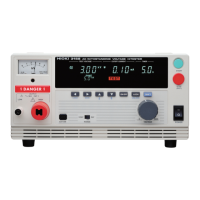16
────────────────────────────────────────────────────
2.9 Connection to the Measured Equipment
────────────────────────────────────────────────────
DANGER
To avoid any life-threatening electric shock accidents, ensure that the
following rules are observed.
・
The AC Withstanding Voltage HiTester is a dangerous product which
discharges high voltages. To prevent getting electrocuted, always
wear high-voltage protective rubber gloves when carrying out any
operation.
・
Be careful when using the product and ensure that you do not touch
this product, any tested object that is connected or any H.V. TEST
LEAD, etc.
・
Make sure that no high voltage is being applied to the output,
confirm the following items, and connect the H.V. TEST LEAD.
(1) The analog voltmeter reads 0 kV.
(2) The DANGER lamp is OFF.
(3) The TEST lamp is OFF.
・
In the TEST state, never touch the output-voltage terminal, H.V. TEST
LEAD, or tested object.
・
Even following a test, there may be a residual voltage at the output
terminal. Therefore, before touching the output-voltage terminal, H.V.
TEST LEAD, or tested object, make sure that no high voltage is being
applied between the output terminals.
NOTE
2.9 Connection to the Measured Equipment
・
If the HIGH and LOW voltage output terminals short-circuit or a dielectric
breakdown occurs in the tested object during the test, noise will be generated and
such noise may lead to a malfunction of this unit or of a nearby electronic device.
If this problem occurs, connect a ferrite core or a resistor to the H. V. TEST
LEAD (high voltage side).
When using a resistor, choose one appropriate for the power rating and withstand
voltage. Also, be alert to any drop in test voltage.
Beware of electric shock when connecting the resistor.
・
Do not the test lead and the EXT/IO cable arranged closely to each other.
Doing so may lead to a malfunction of the external control due to a noise.
Additionally, if the test lead touches to other metallic parts, it may cause an
increase in leakage current.
Prevent the test lead from coming into contact with other parts as much as possible.
(1) Make sure the analog voltmeter is at 0 kV and the DANGER lamp is OFF, and
the TEST lamp is OFF.
(2) Connect the LOW terminal probe to the tested object. Fasten the probe securely
to prevent it from loosening during a test.
(3) Following the procedure described above, connect the HIGH terminal probe to
the tested object.

